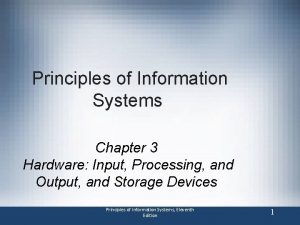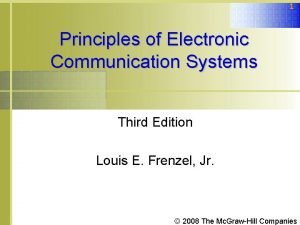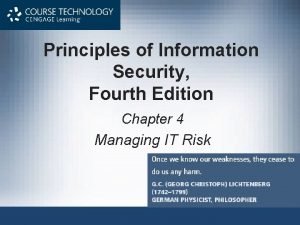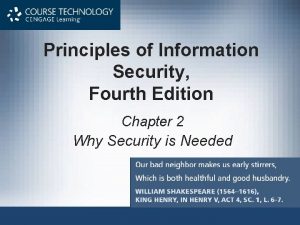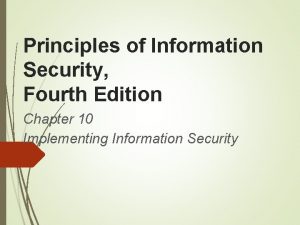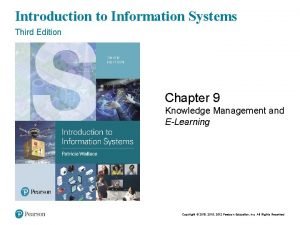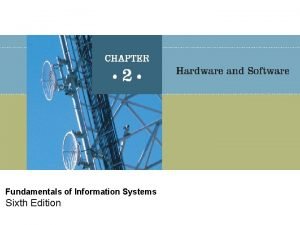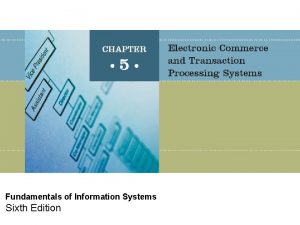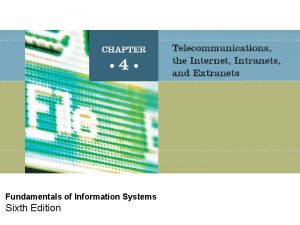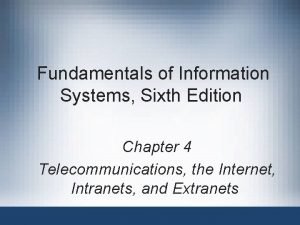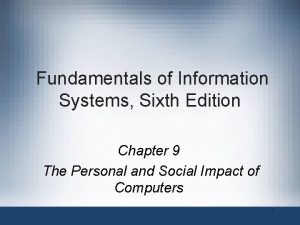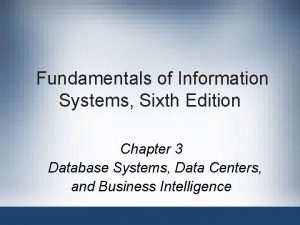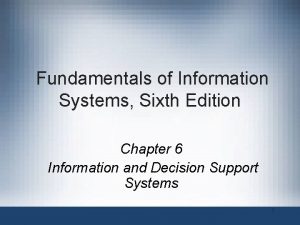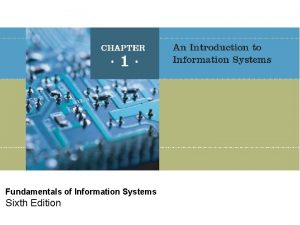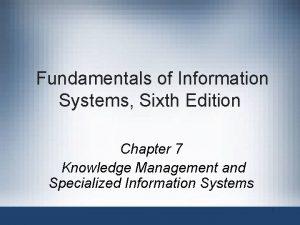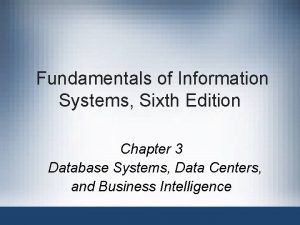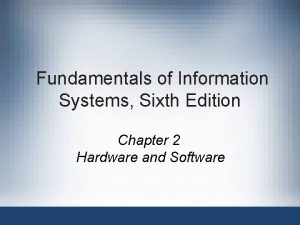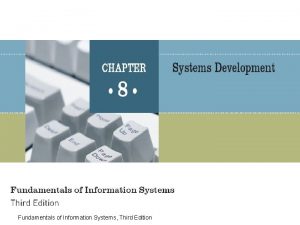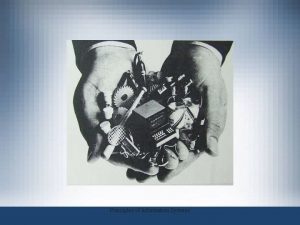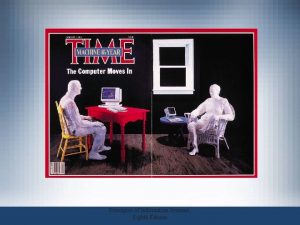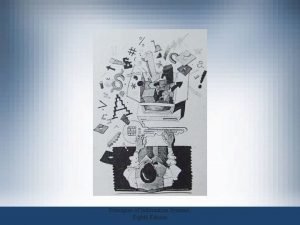Fundamentals of Information Systems Sixth Edition Principles and




























- Slides: 28

Fundamentals of Information Systems Sixth Edition

Principles and Learning Objectives • Effective communications are essential to organizational success. – Define the term telecommunications and describe the function of the components of a telecommunications system. – Identify the three types of telecommunications carriers and discuss the services they provide. – Name three distributed processing alternatives and outline their basic features. Fundamentals of Information Systems, Third Edition. 2

Principles and Learning Objectives (continued) • The Internet is like many other technologies—it provides a wide range of services, some of which are effective and practical for use today, others are still evolving, and still others will fade away from lack of use. – Briefly describe how the Internet works, including alternatives for connecting to it and the role of Internet service providers. Fundamentals of Information Systems, Third Edition. 3

Principles and Learning Objectives (continued) • Originally developed as a document-management system, the World Wide Web is a menu-based system that is easy to use for personal and business applications. – Describe the World Wide Web and the way it works, including the use of Web browsers, search engines, and other Web tools. Fundamentals of Information Systems, Third Edition. 4

Principles and Learning Objectives (continued) • Because the Internet and the World Wide Web are becoming more universally used and accepted for business, management, service, and speed, privacy and security issues must continually be addressed and resolved. – Identify and briefly describe the applications associated with the Internet and the Web. – Define the terms intranet and extranet and discuss how organizations are using them. – Identify several issues associated with the use of networks. Fundamentals of Information Systems, Third Edition. 5

4. 1 An Overview of Telecommunications and Networks. • Telecommunications: the electronic transmission of signals for communications. • Telecommunications medium: anything that carries an electronic signal and interfaces between a sending device and a receiving device. Fundamentals of Information Systems, Third Edition. 6

Figure 4. 1: Elements of a Telecommunications System Fundamentals of Information Systems, Third Edition. 7

Transmission Media Types S. No. Media Type Advantages Used for telephone service, widely avaiable. 1 Twisted-pair wire cable 2 Coaxial cable Cleaner and faster data transmission than 3 Fiber-optic cable Diameter of cable much smaller than coaxial cable, less distortion, high data transmission rates possible. 4 Microwave Avoids costs and efforts to lay cable, capable of high speed transmissions. 5 Cellular Supports mobile users, costs are dropping. 6 Infrared Wireless, operates for short distance, must have unobstructed LOS (line of sight ) operation. twisted-pair wire. Fundamentals of Information Systems, Third Edition. 8

4. 3 Telecommunications Devices Fundamentals of Information Systems, Third Edition. 9

Carriers and Services • Local exchange carrier (LEC): a public telephone company in the United States that provides service to homes and businesses within its defined geographical area. • Competitive local exchange carrier (CLEC): a company that is allowed to compete with the LECs, such as a wireless, satellite, or cable service provider. • Long-distance carrier: a traditional long-distance phone providers. Fundamentals of Information Systems, Third Edition. 10

4. 4 Network Types • Computer network: the communications media, devices, and software needed to connect two or more computer systems or devices. • Network nodes: the computers and devices on the networks. • • • Network Types: Personal area network (PAN) Local area network (LAN) Metropolitan area network (MAN) Wide area network (WAN) International network Fundamentals of Information Systems, Third Edition. 11

Basic Processing Strategies • Centralized processing: all processing occurs in a single location or facility. • Decentralized processing: processing devices are placed at various remote locations. • Distributed processing: computers are placed at remote locations but connected to each other via a network. Fundamentals of Information Systems, Third Edition. 12

Client/server: multiple computer platforms are dedicated to special functions, such as database management, printing, communications, and program execution. Figure 4. 4: Client/Server Connection Fundamentals of Information Systems, Third Edition. 13

4. 5 Communications Software and Protocols • Communications software: software that provides a number of important functions in a network, such as error checking and data security. • Network operating system (NOS) • Network management software. • Communications protocol: a standard set of rules that controls a telecommunications connection. Fundamentals of Information Systems, Third Edition. 14

S. No. Protocols Description 1. Open Systems Interconnections (OSI) A protocol that divides data communication functions into seven distinct layers to simplify the development, operation, and maintenance of complex communication networks. 2. Transmission Control Protocol/Internet Protocol (TCP/IP) The primary telecommunication of the internet developed in the 1970 s. 3. Bluetooth Telecommunication specification that describes how cellular phones, computers, faxes, printers and other electronic devices can be connected wirelessly over short distances (up to 30 feet or so). 4. IEEE 802. 11 b (Wi-Fi) A protocol used to establish a wireless LAN. 5. IEEE 802. 16 (Wi. Max) A protocol designed to support wireless MANs and be compatible with European standards. Table 4. 5 Common Communication Protocols. 15

4. 6 Use and Functioning of the Internet • Internet: a collection of interconnected networks, all freely exchanging information. • Data is passed in chunks called packets. • Internet Protocol (IP): communications standard that enables traffic to be routed from one network to another as needed. • Transmission Control Protocol (TCP): widely used transport-layer protocol that is used in combination with IP by most Internet applications. Fundamentals of Information Systems, Third Edition. 16

The World Wide Web • The Web, WWW or W 3. • A menu-based system that uses the client/server model. • Organizes Internet resources throughout the world into a series of menu pages, or screens, that appear on your computer. • Hypermedia: tools that connect the data on Web pages, allowing users to access topics in whatever order they want. Fundamentals of Information Systems, Third Edition. 17

Internet and Telecommunications Services • E-mail and instant messaging – Instant messaging: a method that allows two or more individuals to communicate online, using the Internet. • Internet cell phones and handheld computers. • Career information and job searching. • Web log (blog): a Web site that people can create and use to write about their observations, experiences, and feelings on a wide range of topics. Fundamentals of Information Systems, Third Edition. 18

• Chat rooms: enable two or more people to engage in interactive “conversations” over the Internet. • Internet phone and videoconferencing services. • Content streaming: a method for transferring multimedia files over the Internet so that the data stream of voice and pictures plays more or less continuously without a break, or very few of them. • Shopping on the Web. • Web auctions. • Music, radio, and video on the Internet. • Other Internet services and applications. Fundamentals of Information Systems, Third Edition. 19

Search Engines • • Search engine: a Web search tool. Examples: Yahoo. com, Google. com Most search engines are free. Searches can use words, such as AND and OR, to refine the search. Fundamentals of Information Systems, Third Edition. 20

4. 7 Intranets and Extranets • Intranet – Internal corporate network built using Internet and World Wide Web standards and products. – Used by employees to gain access to corporate information. – Slashes the need for paper. Fundamentals of Information Systems, Third Edition. 21

• Extranet – A network based on Web technologies that links selected resources of a company’s intranet with its customers, suppliers, or other business partners. • Virtual private network (VPN): a secure connection between two points across the Internet. • Tunneling: the process by which VPNs transfer information by encapsulating traffic in IP packets over the Internet. Fundamentals of Information Systems, Third Edition. 22

Figure 4. 6: Virtual Private Network. Fundamentals of Information Systems, Third Edition. 23

4. 8 Net Issues • Management issues – No centralized governing body controls the Internet. • Service and speed issues – Web server computers can be overwhelmed by the amount of “hits” (requests for pages). – More and more Web sites have video, audio clips, or other features that require faster Internet speeds. Fundamentals of Information Systems, Third Edition. 24

• Privacy – Spyware: hidden files and information trackers that install themselves secretly when you visit some Internet sites – Cookie: a text file that an Internet company can place on the hard disk of a computer system • Fraud – Phishing Fundamentals of Information Systems, Third Edition. 25

• Security with encryption and firewalls – Cryptography: converting a message into a secret code and changing the encoded message back to regular text. – Digital signature: encryption technique used to verify the identity of a message sender for processing online financial transactions. – Firewall: a device that sits between an internal network and the Internet, limiting access into and out of a network based on access policies. Fundamentals of Information Systems, Third Edition. 26

Figure 4. 7: The process of Cryptography. Fundamentals of Information Systems, Third Edition. 27

Self Examination Questions Short Answer Questions (3 marks) 1) Give any THREE types of common Telecommunication Devices. 2) Define computer network and give the different Network Types. 3) Define the different Basic Processing Strategies in the computer networks. 4) What is VPN? Give its diagram. 5) What are the Net Issues? Long Answer Questions (5 marks) 6) Give any FIVE types of Transmission Media with their Advantages. 7) Describe Client/Server system? 8) What is the difference between Communication Software and Communication Protocol? Describe any FIVE types of common Communication Protocols. 9) What is an Internet? List out any SIX types of Internet and Telecommunications services. 10) Write short notes on: (a)World Wide Web (b)Search Engines (c)Intranets and Extranets Fundamentals of Information Systems, Third Edition. 28
 Fundamentals of information systems 9th edition
Fundamentals of information systems 9th edition Fundamentals of information systems 9th edition
Fundamentals of information systems 9th edition Fundamentals of information systems 9th edition
Fundamentals of information systems 9th edition Fundamentals of information systems 9th edition
Fundamentals of information systems 9th edition Principles of economics sixth edition
Principles of economics sixth edition Principles of management information system
Principles of management information system Principles of information systems 11th edition
Principles of information systems 11th edition The sixth sheik's sixth sheep's sick
The sixth sheik's sixth sheep's sick Rubber baby buggy bumpers tongue twister lyrics
Rubber baby buggy bumpers tongue twister lyrics Biochemistry sixth edition 2007 w.h. freeman and company
Biochemistry sixth edition 2007 w.h. freeman and company Expert systems: principles and programming, fourth edition
Expert systems: principles and programming, fourth edition Computer architecture a quantitative approach sixth edition
Computer architecture a quantitative approach sixth edition Automotive technology principles diagnosis and service
Automotive technology principles diagnosis and service Automotive technology sixth edition
Automotive technology sixth edition Citation sample pdf
Citation sample pdf Computer architecture a quantitative approach sixth edition
Computer architecture a quantitative approach sixth edition Precalculus sixth edition
Precalculus sixth edition Computer architecture a quantitative approach sixth edition
Computer architecture a quantitative approach sixth edition Fundamentals of information systems chapter 1
Fundamentals of information systems chapter 1 Introduction to information systems 6th edition
Introduction to information systems 6th edition Principles of electronic communication systems 3rd edition
Principles of electronic communication systems 3rd edition Principles of electronic communication systems 3rd edition
Principles of electronic communication systems 3rd edition Failure of supporting utilities and structural collapse
Failure of supporting utilities and structural collapse Principles of information security 4th edition
Principles of information security 4th edition Principles of information security 4th edition
Principles of information security 4th edition Principles of information security 4th edition
Principles of information security 4th edition Introduction to information systems 6th edition
Introduction to information systems 6th edition Vertical
Vertical Introduction to information systems 3rd edition
Introduction to information systems 3rd edition






